
What's Left on the Free Agent Heap?
Now more than two weeks since the unrestricted free agent period opened on July 1, what's left on the free agent marketplace?
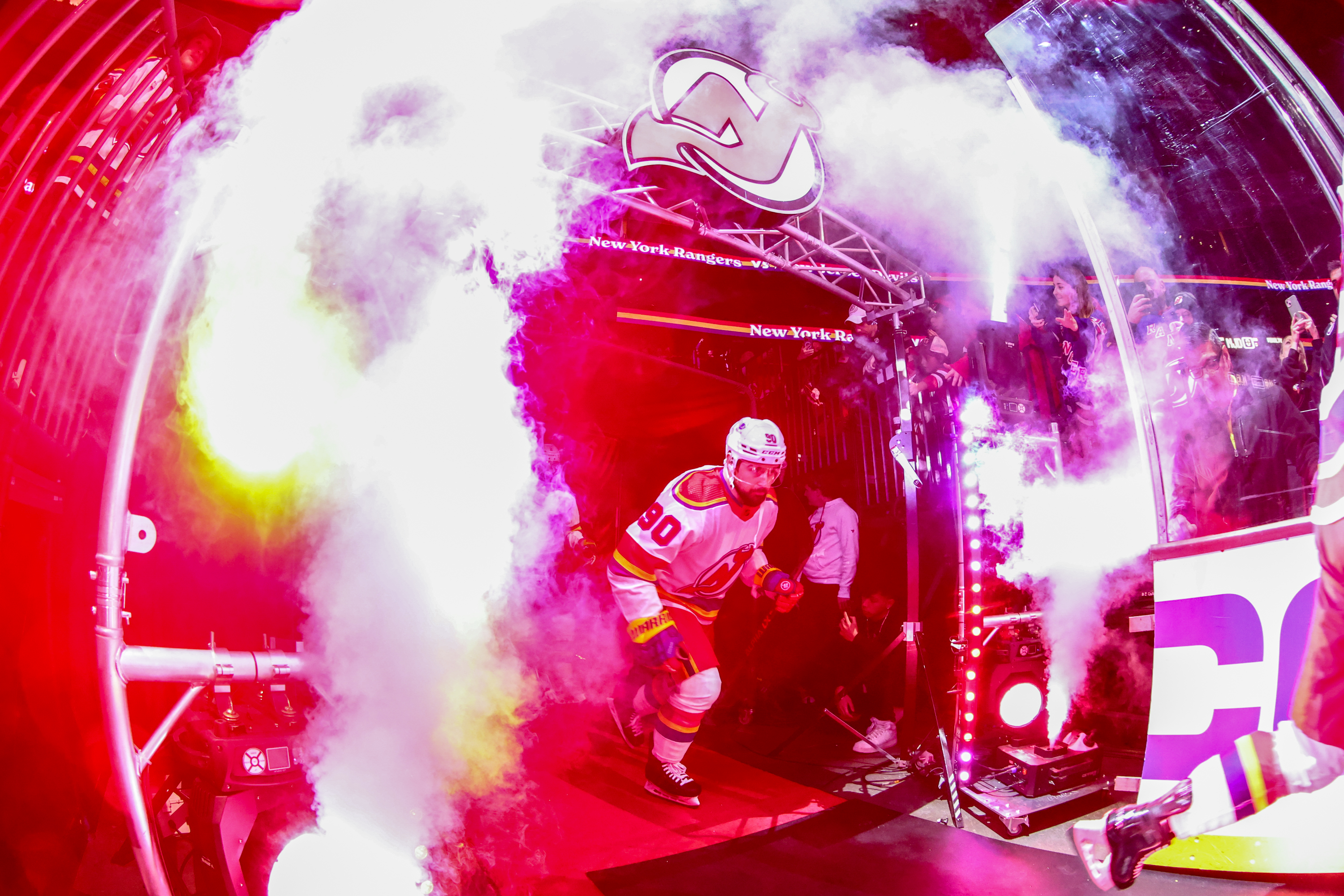 Jan 7, 2023; Newark, New Jersey, USA; New Jersey Devils left wing Tomas Tatar (90) takes the ice before the start of their game against the New York Rangers at Prudential Center. Mandatory Credit: Ed Mulholland-USA TODAY Sports - What's Left on the Free Agent Heap?
Jan 7, 2023; Newark, New Jersey, USA; New Jersey Devils left wing Tomas Tatar (90) takes the ice before the start of their game against the New York Rangers at Prudential Center. Mandatory Credit: Ed Mulholland-USA TODAY Sports - What's Left on the Free Agent Heap?It's been more than two weeks since the NHL league year began anew on July 1st, and the unrestricted free agency period opened. In that time, the majority of the premium players available have been signed, but there remain a handful of not insignificant players yet to ink new deals.
For the Detroit Red Wings, the off-seasons major needs are taken care of.
J.T. Compher's arrival from Colorado reinforces Detroit's center depth chart. Shayne Gostisbehere arrives as a right-shot power play quarterback, checking a pair of boxes. Daniel Sprong, Klim Kostin, and Christian Fischer each provide a different brand of forward depth. Alex Lyon and James Reimer serve as added depth in net. Most important of all, Alex DeBrincat brings scoring nous to a team in desperate need of it.
Given the state of the market and the summer's preceding business, the Red Wings have no need to dip back into the free agent market. However, it's also possible that a match will materialize with a player who expected more on the market and has come to terms with taking something more along the lines of a short-term, below market, "prove-it" deal at a term or cap figure beneath their initial expectations.
With that in mind, I've sub-divided some of the most interesting names left on the market (whether RFAs or UFAs) into the following four categories:
The Un-Gettables: This group is composed of players who would be a worthwhile fit in Detroit, but whose circumstances dictate that to be an unlikely fit for one reason or another. The biggest sub-category in this group is restricted free agents, whom we know NHL general managers to be constitutionally unwilling to target with offer sheets.
The Old Friends: This group includes former Red Wings who might make sense for another year in Hockeytown.
The Old: This group features players who might have been exciting to sign as free agents three-to-five seasons ago, but now...
The Intriguing: This final group features players who might just be able to fill a void in the 2023-24 Red Wing line-up. They might not have been top of mind on July 1st, but they could be worth a cut-rate flyer.
The Un-Gettables
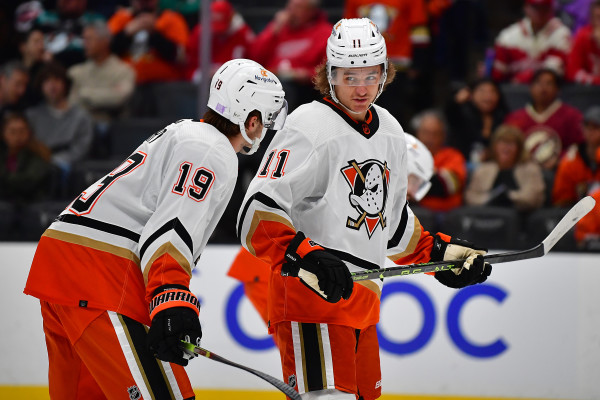
Trevor Zegras and Troy Terry, RFA forwards, Anaheim Ducks
With $54,439,167 on the books for the 2023-24 season, the Anaheim Ducks are comfortably beneath the NHL's salary cap floor of $61.7 million. Despite that, their two most important players—Zegras and Terry—remain un-signed restricted free agents.
Zegras (22) and Terry (25) are two of the league's most dynamic young players, and in theory, there should be no shortage of suitors around the league for them. Both are the kind of skillful young scorers the Red Wings coveted entering the summer. To be clear, these aren't players who Detroit could sign on a one-year, low cost gamble; it would require an offer sheet of significant AAV and term to even start the conversation.
Between cap space and draft capital though, it's difficult to imagine a scenario in which any team could sign either player to a contract the Ducks couldn't and wouldn't match.
However, the reality is that NHL teams and GMs aren't interested in building via restricted free agency, and both young Ducks will all but assuredly sign long-term extensions in Anaheim.
If ever a team were vulnerable to RFA poachings, they would have to be tight against the salary cap, and the Ducks are anything but. Either Terry or Zegras would be fun, exciting, and useful, but it isn't happening.
Patrice Bergeron and David Krejci, UFA centers, Boston Bruins
Bergeron and Krejci aren't restricted free agents, but it's almost unimaginable that either would sign an NHL contract for the '23-24 season outside Boston. In both cases, the alternative looks to be retirement.
The best 200-foot player of his generation, so dominant the Selke Trophy may wind up bearing his name, Bergeron is now a week away from 38 years old, and the signs of the mileage on his body are showing. Krejci, who turned 37 in April, was never the player Bergeron was, but 56 points in 70 games a year ago is nothing to sneeze at.
Of the two, it's easier to picture Krejci signing elsewhere, but even that seems a bit far-fetched. Both could certainly have fit into the Old category here, and it's more than fair to wonder whether either player can come anywhere close to contributing what you learned to associate with the names Bergeron and Krejci over their robust careers.
For the Red Wings, the reality is that evaluating their remaining potential is meaningless; far more likely than not, it's the Bruins or retirement for Bergeron and Krejci.
Evan Bouchard, RFA defenseman, Edmonton Oilers
Bouchard brings us back to the world of restricted free agency, and unlike Terry and Zegras' Ducks, his Edmonton Oilers are in narrow salary cap straits. Our friends at PuckPedia have the Oilers at a shade less than $6.4 million of cap space for the coming season.
That should be more than enough to bring back Bouchard, a blossoming 23-year-old. defenseman. However, a team eager to bring in a young and offensively gifted right-shot defenseman with cap space to spare could put Oilers GM Ken Holland in some trouble with a lucrative offer sheet.
Signing Bouchard to a contract with an AAV between $6,435,187 - $8,580,250 would send a first, second, and third round pick back to Oilers. Bouchard might be intrigued by a contract that would be more valuable than Edmonton could afford to keep around. The team making the play for Bouchard would have to be at peace with signing him to a more expensive contract than the market dictates he deserves.
The Oilers have already jettisoned whatever spare parts weren't nailed down (including Klim Kostin and Kailer Yamamoto to Detroit) to clear cap space, so there isn't much wiggle room to maneuver further and make more.
At the beginning of the summer, the Red Wings might have fit the description of a team that could make a play for Bouchard. They had plenty of picks and cap space, and they coveted a right-shot D with offensive upside and power play experience.
After its free agency business though, it's harder to see how Bouchard makes sense in Detroit. Throw in the fact that Steve Yzerman and Holland are former colleagues along with the general reticence around RFAs, and it's close to inconceivable that Bouchard winds up a Red Wing.
The Old Friends
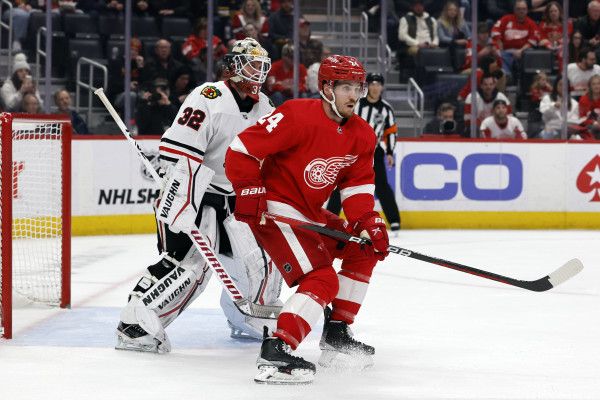
Alex Chiasson, Adam Erne, and Pius Suter, UFA forwards, Detroit Red Wings
Three un-signed 2022-23 Red Wings could find their way into the '23-24 mix under the right circumstances. None of Chiasson, Erne, or Suter should command a contract of serious commitment (as evidenced by their status as UFAs on July 17th), so all could make sense in a bottom six role.
Unfortunately for Chiasson and Erne, I fear that Detroit's depth reinforcements and soon-to-arrive prospects make it hard to see a place for them with the Red Wings going forward.
Suter, though, might be a different story. His shutdown game would seem to fit with Detroit's vision of controlling play on the strength of two-way centermen. At 27, Suter is four years older than Joe Veleno, who projects at present as the Wings' fourth center. As such, you wouldn't expect him to have as much room to grow as Veleno, but I don't think it's far-fetched to argue that Suter is better suited for that fourth center role right now than Veleno is.
Suter's last deal was for two years at $3.25 million per season. Detroit could easily give Suter that salary on a one-year deal this summer as a short-term option, or it might make sense to sign a longer deal at a lesser cap number (if that's amenable to Suter).
Whatever Suter's options, his present availability leaves a return to Detroit on the table, if nothing more.
Tomas Tatar, UFA winger, New Jersey Devils
Tomas Tatar left Detroit after six seasons and change at the 2018 trade deadline, going off to Vegas at the cost of a first, second, and third round pick. It was an extraordinary haul at the time, and, since then, Tatar has changed teams twice more.
He was sent to Montreal in the trade that brought Max Pacioretty to the Golden Knights, and he signed as a free agent with the Devils two summers ago. Now out of contract again, Tatar is fresh off a reasonably productive year in New Jersey: 20 goals and 28 assists.
The tricky thing for Tatar, as he has found out, is that the market for scoring wingers in the cap-crunched, post-COVID NHL is limited. When it's time to cut costs, the point-producing winger often winds up the first on the chopping block, and most teams (understandably) would rather use their scant cap space to lock up centers and defensemen.
There are exceptions, to be sure, in the form of premium players like David Pastrnak or Mark Stone, who can command center wages from the flank, but, for wingers who are merely good instead of elite, the market can be unfriendly.
The real question for a Tatar-Detroit reunion though has more to do with fit. Between Alex DeBrincat and Daniel Sprong, Steve Yzerman has recruited two players who fit the "scoring winger" profile to the Red Wings already this summer. It's a bit hard to imagine that a third in Tatar makes much sense.
The Old
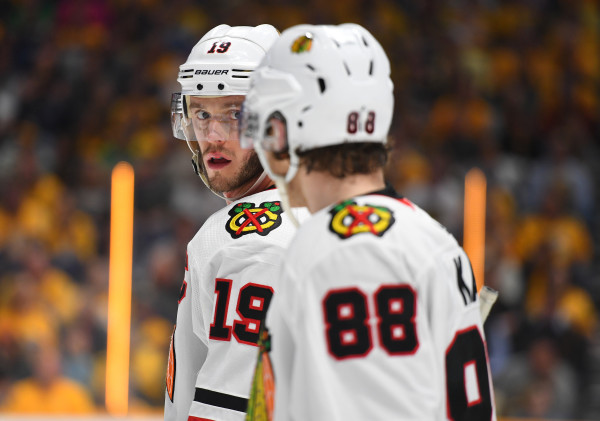
Patrick Kane and Jonathan Toews, UFA forwards, Chicago Blackhawks (and I guess technically New York Rangers)
Kane finished the year (in ignominious fashion) with the Rangers last season, but I've grouped these two together because of their long history together in Chicago. Both are inarguably among the best players of their generation, but with Kane now 34 and Toews 35, it's dubious that either can offer much to a team in 2023-24.
The most pressing reason for that reality is injury. For Toews, retirement sounds like a very serious consideration, and it's not hard to see why when you consider all he accomplished as a player and his battle with long COVID. Kane, meanwhile, underwent hip re-surfacing surgery with a four to six month recovery timeline on June 1st.
From Kane's perspective, that means there isn't a rush to find a new team to call home, but it also raises the risk factor on whatever contract he signs next quite a bit. While some may be tempted by his history with Alex DeBrincat, the Patrick Kane of the 2023 postseason did not look like a player who can bring something the Red Wings lack.
Once upon a time, an un-signed Kane or Toews in the UFA shop window would've commanded years of term and a double-digit cap hit as the get-in-the-door price. In 2023, that's no longer the case.
Vladimir Tarasenko and Phil Kessel, UFA snipers, New York Rangers and Vegas Golden Knights
Tarasenko and Kessel aren't in the same spot in their careers as one another, but their profiles are quite similar: at their best, capable scorers who won't do much else.
Taraensko is now 31 and Kessel 35. The former decided to adopt CAA and Pat Brisson as his representation two weeks ago after being disappointed with the offers on the table for him at the onset of free agency. The latter played in all 82 regular season games for the Golden Knights last year but cracked the post-season line-up just four times as Vegas marched to the Cup.
For Kessel, retirement has to be a legitimate consideration, while Tarasenko's agent swap suggests he is intent on continuing his career. Tarasenko scored 18 goals and 32 assists in 69 games split between the Blues and Rangers last year. That's respectable, but as for Tatar, with the likes of DeBrincat and Sprong already aboard, it's hard to see a fit for Detroit.
The Intriguing
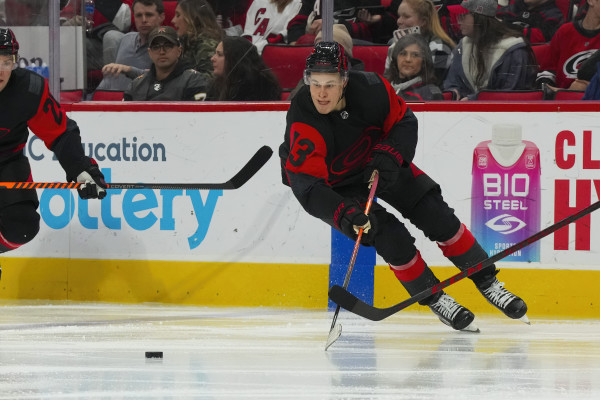
Jesse Puljujarvi, UFA winger, Carolina Hurricanes
Puljujarvi has been a lightning rod amongst hockey fans for some time now, and his personal history isn't unlike that of Filip Zadina. He could never score enough to live up to the expectations foisted on him by his draft status (fourth overall in 2016), and he could never win over the Oiler organization that drafted him in a depth role.
Puljujarvi moved at the 2023 trade deadline to Carolina, where, if nothing else, he looked like a fit. Puljujarvi has spent his career driving outstanding underlying results, while being inept when it comes to finishing chances. That's more or less the Hurricanes special. In Carolina though, he never locked down a role and played in just seven of the Canes' 15 playoff games.
This summer, the winger also underwent double hip surgery, which only complicates his path to an NHL roster next season futher, and it's possible his professional future will come in Europe rather than North America.
Still, at his best, Puljujarvi's wall play and defense could make him a useful player in a limited role.
Alexis Lafreniere, RFA winger, New York Rangers
You could make the case that Lafreniere belongs in the "un-gettable" category, but I'm not sure I'm buying it. Like Terry and Zegras, this hypothetical move is an outlier on this list in that a short-term, low-cost contract won't get it done, and instead, the barrier to entry is a robust offer sheet.
As it stands, the primary impediment to the Rangers moving on from Lafreniere is the draft pick they used to choose him: number one overall in 2020. In three seasons with the Rangers, he has yet to offer any compelling case as to why he was selected that high, but it has to be difficult for New York to stomach the thought of moving on from a player they once selected at the top of the draft.
Lafreniere set a career high in points a year ago with 39, but the Rangers' salary cap woes and his general struggle to meet expectations of a number one overall pick mean New York must at least consider an offer should it arrive. With that said, New York would be selling Lafreniere somewhere near the nadir of his value, and it's not clear that Detroit is in the market for a reclamation project up front.
The most likely scenario is that the Quebecois forward signs a bridge deal to remain a Ranger and either proves his worth or moves on by that deal's conclusion. Nonetheless, in an alternate universe in which NHL team did traffic in offer sheets, Lafreniere might be an interesting name to watch.
Tyler Motte, UFA winger, New York Rangers
Now 28, Tyler Motte is no mystery. He won't light up the scoresheet or play in the top six, but he can be useful in a defense-first bottom six role. Motte finished last season with the Rangers, after being traded there from Ottawa at the deadline. He finished the prior year in New York as well, having been traded there from Vancouver at that season's deadline.
A native of Port Huron, Motte has plenty of ties to his home state. He spent three seasons at the University of Michigan, where he played with Dylan Larkin, J.T. Compher, and Andrew Copp. If Detroit harbors any ambition of prying Kyle Connor from Winnipeg, perhaps Motte—who along with Compher and Connor composed Michigan's vaunted CCM line in 2015-16—could be the hook.
On a more serious note, Motte's last contract (signed by the Senators) was for one year and just $1.35 million. At that number, he could be a useful if inessential depth option for the Red Wings.
Matt Dumba, UFA defenseman, Minnesota Wild
Dumba is the sort of player who spent so much of his career mired in trade rumors that it's hard to believe he's remained a Wild for all ten of his NHL seasons.
His last contract was for five years at a $6.0 million AAV. Both those figures are out of the question for his next deal; he never grew into that deal as the Wild might have hoped. That doesn't mean he can't be of use to some team out there though, and, for Dumba, Detroit would seem like a decent option.
Realistically, Dumba's best bet at this stage in the process is to find a destination where he can sign a one-year deal, enjoy a renaissance season of sorts, and cash in on a more lucrative ticket next summer, when the salary cap will hopefully have climbed. His minutes wouldn't be assured in Detroit by any means, not this late into the free agent process, but his path to the line-up wouldn't be extreme either.
From a Detroit perspective, you can never have too many defensemen, so it's hardly magical thinking to suggest the two sides could come together on a low-risk, short-term deal.